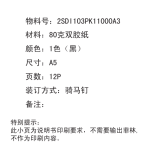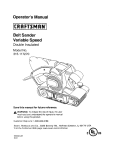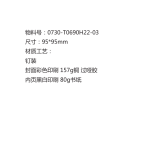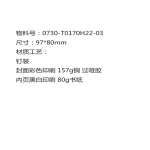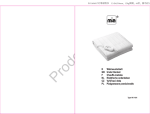Download Worx WX661 Instruction manual
Transcript
物料号:2SBS023PK11000A0
材料:100克双胶纸
颜色:1色(黑)
尺寸:A5
页数:12P
装订方式:骑马钉
备注:
特别提示:
此小页为说明书印刷要求,不需要输出菲林,
不作为印刷内容。
SAFETY AND OPERATING MANUAL
Belt sander
WX661 WX661.1
General Power Tool
Safety Warnings
WARNING! Read all safety warnings
and all instructions. Failure to follow
the warnings and instructions may result in
electric shock, fire and/or serious injury.
Save all warnings and instructions for
future reference.
The term “power tool” in the warnings refers
to your mains-operated (corded) power tool or
battery-operated (cordless) power tool.
1) Work area safety
a) Keep work area clean and well lit.
Cluttered or dark areas invite accidents.
b)Do not operate power tools in
explosive atmospheres, such as in the
presence of flammable liquids, gases
or dust. Power tools create sparks which
may ignite the dust or fumes.
c)Keep children and bystanders
away while operating a power tool.
Distractions can cause you to lose control.
2)Electrical safety
a) Power tool plugs must match the
outlet. Never modify the plug in any
way. Do not use any adapter plugs
with earthed (grounded) power tools.
Unmodified plugs and matching outlets
will reduce risk of electric shock.
b)Avoid body contact with earthed or
grounded surfaces, such as pipes,
radiators, ranges and refrigerators.
There is an increased risk of electric shock
if your body is earthed or grounded.
c)Do not expose power tools to rain or
wet conditions. Water entering a power
tool will increase the risk of electric shock.
d)Do not abuse the cord. Never use
the cord for carrying, pulling or
unplugging the power tool. Keep cord
away from heat, oil, sharp edges or
moving parts. Damaged or entangled
cords increase the risk of electric shock.
e)When operating a power tool
outdoors, use an extension cord
suitable for outdoor use. Use of a cord
suitable for outdoor use reduces the risk of
Belt sander
electric shock.
f) If operating a power tool in a damp
location is unavoidable, use a residual
current device (RCD) protected
supply. Use of an RCD reduces the risk of
electric shock.
3) Personal safety
a) Stay alert, watch what you are
doing and use common sense when
operating a power tool. Do not use
a power tool while you are tired or
under the influence of drugs, alcohol
or medication. A moment of inattention
while operating power tools may result in
serious personal injury.
b)Use personal protective equipment.
Always wear eye protection. Protective
equipment such as dust mask, nonskid safety shoes, hard hat, or hearing
protection used for appropriate conditions
will reduce personal injuries.
c)Prevent unintentional starting. Ensure
the switch is in the off-position before
connecting to power source and/or
battery pack, picking up or carrying
the tool. Carrying power tools with your
finger on the switch or energising power
tools that have the switch on invites
accidents.
d)Remove any adjusting key or wrench
before turning the power tool on. A
wrench or a key left attached to a rotating
part of the power tool may result in
personal injury.
e)Do not overreach. Keep proper
footing and balance at all times. This
enables better control of the power tool in
unexpected situations.
f) Dress properly. Do not wear loose
clothing or jewellery. Keep your
hair, clothing and gloves away from
moving parts. Loose clothes, jewellery or
long hair can be caught in moving parts.
g)If devices are provided for the
connection of dust extraction and
collection facilities, ensure these are
connected and properly used. Use
of these devices can reduce dust-related
hazards.
WX661 WX661.1
4)Power tool use and care
a) Do not force the power tool. Use
the correct power tool for your
application. The correct power tool will
do the job better and safer at the rate for
which it was designed.
b)Do not use the power tool if the
switch does not turn it on and off.
Any power tool that cannot be controlled
with the switch is dangerous and must be
repaired.
c)Disconnect the plug from the power
source and/or the battery pack from
the power tool before making any
adjustments, changing accessories,
or storing power tools. Such preventive
safety measures reduce the risk of starting
the power tool accidentally.
d)Store idle power tools out of the
reach of children and do not allow
persons unfamiliar with the power
tool or these instructions to operate
the power tool. Power tools are
dangerous in the hands of untrained users.
e)Maintain power tools. Check for
misalignment or binding of moving
parts, breakage of parts and any other
condition that may affect the power
tool’s operation. If damaged, have the
power tool repaired before use. Many
accidents are caused by poorly maintained
power tools.
f) Keep cutting tools sharp and clean.
Properly maintained cutting tools with
sharp cutting edges are less likely to bind
and are easier to control.
g)Use the power tool, accessories and
tool bits etc. in accordance with these
instructions, taking into account the
working conditions and the work to
be performed. Use of the power tool for
operations different from those intended
could result in a hazardous situation.
5)Service
a) Have your power tool serviced by
a qualified repair person using only
identical replacement parts. This will
ensure that the safety of the power tool is
maintained.
Belt sander
SAFETY INSTRUCTIONS
WARNING! When using electric tools
basic safety precautions should always
be followed to reduce the risk of fire, electric
shock and personal injury including the
following.
Read all these instructions before attempting
to operate this product and save these
instructions.
This appliance is not intended for use by
persons (including children) with reduced
physical, sensory or mental capabilities, or
lack of experience and knowledge, unless they
have been given supervision or instruction
concerning use of the appliance by a person
responsible for their safety.
Children should be supervised to ensure that
they do not play with the appliance.
Safe operation
1. Keep work area clear
– Cluttered areas and benches invite injuries.
2. Consider work area environment
– Do not expose tools to rain.
– Do not use tools in damp or wet locations.
– Keep work area well lit.
– Do not use tools in the presence of
flammable liquids or gases.
3. Guard against electric shock
– Avoid body contact with earthed or
grounded surfaces {e.g. pipes, radiators,
ranges, refrigerators).
4. Keep other persons away
– Do not let persons, especially children, not
involved in the work touch the tool or the
extension cord and keep them away from
the work area
5. Store idle tools
– When not in use, tools should be stored
in a dry locked-up place, out of reach of
children.
6. Do not force the tool
– It will do the job better and safer at the
rate for which it was intended.
7. Use the right tool
– Do not force small tools to do the job of a
heavy duty tool.
– Do not use tools for purposes not
intended; for example do not use circular
saws to cut tree limbs or logs.
WX661 WX661.1
8. Dress properly
– Do not wear loose clothing or jewellery,
they can be caught in moving parts.
–Non-skid footwear is recommended when
working outdoors.
– Wear protective hair covering to contain
long hair.
9. Use protective equipment
– Use safety glasses.
– Use face or dust mask if working
operations create dust.
10. Connect dust extraction
equipment
–If the tool is provided for the connection of
dust extraction and collecting equipment,
ensure these are connected and properly
used.
11. Do not abuse the cord
– Never yank the cord to disconnect it from
the socket Keep the cord away from heat,
oil and sharp edges.
12. Secure work
– Where possible use damps or a vice to
hold the work. It is safer than using your
hand.
13. Do not overreach
– Keep proper footing and balance at all
times.
14 - Maintain tools with care
– Keep cutting tools sharp and clean for
better and safer performance.
– Follow instruction for lubricating and
changing accessories.
–Inspect tool cords periodically and if
damaged have them repaired by an
authorized service facility.
– Inspect extension cords periodically and
replace if damaged.
– Keep handles dry, clean and free from oil
and grease.
15. Disconnect tools
– When not in use, before servicing and
when changing accessories such as
blades, bits and cutters, disconnect tools
from the power supply.
16. Remove adjusting keys and
wrenches
– Form the habit of checking to see that keys
and adjusting wrenches are removed from
the tool before turning it on.
Belt sander
17. Avoid unintentional starting
–Ensure switch is in “off” position when
plugging in
18. Use outdoor extension leads
– When the tool is used outdoors, use only
extension cords intended for outdoor use
and so marked.
19. Stay alert
– Watch what you are doing, use common
sense and do not operate the tool when
you are tired.
20. Check damaged parts
– Before further use of tool, it should be
carefully checked to determine that it will
operate properly and perform its intended
function.
– Check for alignment of moving parts,
binding of moving parts, breakage of
parts, mounting and any other conditions
that may affect its operation.
– A guard or other part that is damaged
should be properly repaired or replaced
by an authorized service centre unless
otherwise indicated in this instruction
manual.
–Have defective switches replaced by an
authorized service centre.
– Do not use the tool if the switch does not
turn it on and off.
21. Warning
– The use of any accessory or attachment
other than one recommended in this
instruction manual may present a risk of
personal injury.
22. Have your tool repaired by a
qualified person
– This electric tool complies with the
relevant safety rules. Repairs should only
be carried out by qualified persons using
original spare parts, otherwise this may
result in considerable danger to the user.
23.If the replacement of the supply
cord is necessary, this has to be
done by the manufacturer or his
agent in order to avoid a safety
hazard.
24. For tools intended to be
connected to a water supply:
– Replacement of the plug or the supply
cord shall always be carried out by the
WX661 WX661.1
–
manufacturer of the tool or his service
organisation,
Keep water clear off the electrical parts
of the tool and away from persons in the
working area.
Additional Safety
Rules
1. Always wear eye protection.
2. Do not operate your machine until it
is completely assembled and installed
according to the instructions.
3.If you are not thoroughly familiar with the
operation of abrasive finishing machines,
obtain advice from your supervisor,
instructor or other qualified person.
4. Caution: This machine is designed to sand
wood or wood-like products only. Sanding
or grinding other materials could result in
fire, injury or damage to product.
5. This MACHINE is intended for indoor use
only.
6.Important: Mount and use this machine
on horizontal surfaces only. Operating
machine when mounted on non-horizontal
surfaces might result in motor damage.
7.If there is any tendency for the machine to
tip over or move during certain operations
such as when sanding long or heavy
boards, the machine must be securely
fastened to a supporting surface.
8. Make sure the sanding belt is tracking
correctly in order that it does not run off
the pulleys.
9. Make sure the sanding belt runs in the
proper direction. See directional arrow on
back side of belt.
10. Make sure the sanding belt or disc is not
torn or loose.
11. Support workpiece firmly with the miter
gage, backstop or work table when
sanding with the belt.
12.Note: The only exception is curved work
performed on the top wheel of belt.
13. Always hold the workpiece firmly on the
table when sanding on the disc.
14. Avoid kickback by sanding in accordance
with directional arrows. Sand on
Belt sander
downward side of disc. Sanding on the
upward side could cause the workpiece to
fly up causing injury.
15. Always maintain a minimum clearance
of 1/16” or less between the table or
backstop and the sanding belt or disc.
16.Never wear gloves or hold the work with a
rag when sanding.
17. Sand with the grain of the wood.
18. Do not sand pieces of material that are too
small to be safely supported.
19. Avoid awkward hand positions where a
sudden slip could cause a hand to move
into the sanding belt or disc.
20. When sanding a large workpiece, provide
additional support at table height.
21. Do not sand with the workpiece
unsupported. Support the workpiece with
the backstop or table. The only exception
is curved work performed on the outer
sanding drum.
22. Always remove scrap pieces and other
objects from the table, backstop or belt
before turning the machine “ON.”
23.Never perform layout, assembly or set-up
work on the table while the sander is
operating.
24.Never leave the machine work area when
the power is “ON” or before the machine
has come to a complete stop.
25.Never use solvents to clean plastic parts.
Solvents could possibly dissolve or
otherwise damage the material. Only a
soft damp cloth should be used to clean
plastic parts.
26. Should any part of your sander be
missing, damaged, or fail in any way, or
any electrical components fail to perform
properly, shut off switch and remove
plug from power supply outlet. Replace
missing, damaged or failed parts before
resuming operation.
27. The use of attachments and accessories
not recommended by manufacture may
result in the risk of injuries.
28.
WARNING: Some dust particles
created by power sanding, sawing,
grinding, drill and other construction jobs
contain chemicals known to cause cancer,
birth defects or other reproductive harm.
WX661 WX661.1
Some examples of these chemicals are:
Lead from lead-based paints.
Crystalline silica from bricks and cement
and other masonry products.
• Arsenic and chromium from chemically
treated lumber.
Your risk from these exposures varies,
depending upon how often you do this type
of work. To reduce your exposure to these
chemicals:
• Work in a well-ventilated area.
• Work with approved safety equipment,
such as those dust masks that are specially
designed to filter microscopic particles.
•
•
SYMBOLS
To reduce the risk of injury, user
must read instruction manual
Double insulation
Warning
Wear ear protection
Wear eye protection
Wear dust mask
RCM approval mark
Belt sander
WX661 WX661.1
1
2
3
4
10
5
9
8
7
6
1. Variable Speed Control
2. ON/OFF Switch
3. Switch lock-on button
4. Hand Grip Areas
5. Dust Bag
6. Dust extraction outlet
7. Belt Tension Release Lever
8. Rotation Direction Arrow
9. Belt Centering Control Knob
10. Front handle
11. Sanding belt (See Fig. D)*
12. Base-plate (See Fig. D)
13. Dust extraction adapter (See Fig. F, G)
*Not all the accessories illustrated or described are included in standard delivery.
Belt sander
WX661 WX661.1
TECHNICAL DATA
Rated voltage
Rated power
Rated no load speed
220-240V~50Hz
950W
240-350/min
Belt size
76mmx533mm
Sanding area
76mmx130mm
Protection class
/II
Machine weight
3.3kg
ACCESSORIES
Dust bag
Sanding belt (80 grit)
35 mm Dust extraction adapter
32 mm Dust extraction adapter
1
2
1
1
We recommend that you purchase your accessories from the same store that sold you the tool.
Use good quality accessories marked with a well-known brand name. Choose the type according
to the work you intend to undertake. Refer to the accessory packaging for further details. Store
personnel can assist you and offer advice.
Belt sander
WX661 WX661.1
OPERATING INSTRUCTIONS
b
a
NOTE: Before using the tool, read the instruction
book carefully.
Intended Use
The machine is intended for dry sanding–with high
removal capacity–of wood, plastic, metal, filler as well
as varnished surfaces.
1. ON/OFF SWITCH
E
Depress to start and release to stop your tool.
A
2. SWITCH LOCK-ON BUTTON (See Fig. A)
Depress on/off switch (2) then lock on button (3). Your
tool is now locked on for continuous use. To switch off
your tool just depress and release the on/off switch.
3. VARIABLE SPEED CONTROL DIAL
13a
Adjust the variable speed control (1) to increase
or
decrease the speed according to the material and
sanding belt specification to be used (also possible
during no load operation).
See the table below for
F
general guidance on speed selection. Avoid prolonged
use at very low speed as this may damage your
sander’s motor.
B
Material
5-6
80
Veneer
2-4
150
Chipboard
1-5
60/80
Plastics
2-5
100
5-6
80
6
40/60
Balsa Wood
1-3
100
Acrylic
1-2
100
Paint
Removal
12
Belt Grit
Solid Wood
Steel
C
Speed selection
G
13b
11
D
Belt sander
4. CHANGING A SANDING BELT (See Fig. B, C)
WARNING! Remove the main plug from the
socket before changing sanding belt.
Pull the lever (7) to release the belt tension. Remove
and fit a new belt over both rollers. Ensure the direction
of rotation arrows on the belt and the sander are the
same. Close the lever to tension the belt.
WX661 WX661.1
5. BELT CENTERING CONTROL (See Fig. D)
WARNING! Wear eye protection before
carrying out a belt centering adjustment.
b down, hold it firmly with
Turn the machine upside
one hand, start the motor and release the switch
immediately after observing tracking of sanding belt.
If abrasive belt runs a
outward, turn tracking adjustment
knob (9) counter-clockwise and clockwise if belt runs
inward. Adjust the belt until the outer edge of the belt
is even with the outer edge of the base-plate (12). Belt
life will
A be greatly increased by keeping the tracking
adjustment set properly.
E
6. DUST BAG (See Fig. E)
You must use the dust collection bag provided to collect
the dust produced during sanding. To attach, insert the
dust collection bag into the dust extraction outlet. Make
sure the dots of the outlet are locked in the slot of the
dust bag. When the dust collection bag is full, remove
and empty by opening the zip on the dust bag (5).
7. Assemble the dust extraction
adapter(See
Fig. F, G)
B
Your sander is equipped with a dust extraction adapter,
which is designed for letting you attach a
wet/dry vac for collecting dust better . Insert the
suitable size adapter into the outlet until it is secured
Insert the 35mm adapter (13a) into the outlet until it
is secured (See Fig.F), then insert the 32 mm adapter
(13b) into the back of the 35 mm adapter (See Fig. G).
8. DRIVE BELT REPLACEMENT.
WARNING! Remove the main plug from
the socket before carrying out a drive belt
C
replacement.
Remove the two screws and the belt cover as shown.
Carefully cut the drive belt if not already broken and
remove from your belt sander. Fit your new drive belt
12 pulley. Then install onto the small
around the large
pulley by rotating
clockwise and pushing the drive belt
11
shown around the small pulley at the same time. The
drive belt will be a tight fit. Fit the belt cover and two
screws.
13a
F
13b
G
D
Belt sander
WX661 WX661.1
WORKING HINTS FOR YOUR
BELT SANDER
If your power tool becomes too hot, especially
when used at low speed, set the speed to
maximum and run with no load for 2-3
minutes to cool the motor. Avoid prolonged
usage at very low speed. Always use a
sanding belt suited to the material you wish
to sand. Always ensure the work-piece is
firmly held or clamped to prevent movement.
Support large panels close to the sanding
area. Any movement of the material may
affect the quality of the sanding finish. Start
your sander before sanding and turn off only
after stopping sanding. For best results sand
wood in the direction of the grain. Do not start
sanding without the sanding belt fitted. Empty
the dust bag every 5 minutes or sooner to
ensure efficient dust collection.
MAINTAINANCE
Remove the plug from the socket before
carrying out any adjustment, servicing or
maintenance.
Your power tool requires no additional
lubrication or maintenance. There are no user
serviceable parts in your power tool. Never
use water or chemical cleaners to clean your
power tool. Wipe clean with a dry cloth.
Always store your power tool in a dry place.
Keep the motor ventilation slots clean. Keep
all working controls free of dust. Occasionally
you may see sparks through the ventilation
slots. This is normal and will not damage your
power tool.
If the supply cord is damaged, it must be
replaced by the manufacturer, its service
agent or similarly qualified persons in order to
avoid a hazard.
Belt sander
WX661 WX661.1
Copyright © 2012, Positec. All Rights Reserved.
2SBS023PK11000A0













